The foolhardy and the bored can now officially navigate through my first 37 Highlander posts—the ones about the original movie— in order via helpful links. In my defense, going back and fixing that was exactly as boring as I thought it would be.
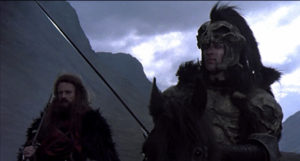
Can we start a new rule that watching movies with lots of fire will melt actual snow?
Why Found-Again? Here are the things I remembered about Legend before rewatch:
I’m not so sure about that last part anymore.
The Premise: Mischievous (read: a jerk) princess Lili (Mia Sara) spends all her free time with half-feral forest boy Jack (Tom Cruise). When a unicorn viewing goes horribly awry and allows goblins to kill one of the beasts, winter falls upon the land, and a separated Jack and Lili try to undo the damage she caused. Jack joins in with a mob of capricious faeries, while Lili is captured and slated to become the bride of Darkness.
I sometimes wonder if I’ve become more susceptible to background music as I get older, because I was keyed up through most of Legend in a way I didn’t remember from my youth, even knowing what was going to happen. (It’s doubly odd because I could have sworn the unicorn maiming was more graphic than we actually see here; if anything, I had less to worry about.) I also didn’t remember Lili being as irritating as she proved to be, which improved the story; her temptation by Darkness, perhaps the most famous part of the film, isn’t the attack on an innocent girl I recalled so much as a logical attempt to play on Lili’s character flaws.
The movie is certainly heavy-handed in some respects, but the only real weak point in my re-viewing was the final fight…though the swordplay seems like a good, solid background for building an interest in Highlander later on. Even the music is different in those scenes, as if Jerry Goldsmith had stepped out for coffee and John Williams started doodling on his paper, and I found myself looking around for Indiana Jones when I should have been watching evil get defeated.
Legend was the first role I ever saw Tim Curry in, and I managed to become a fan without knowing what he actually looked like for a good two years. As attractive as the unicorns and candy-colored forests are, his Darkness makes the movie…and, disturbingly, no small amount of sense sometimes. In the ’80s, the parochial-school kid in me thought of him only as the devil, but the performance never lets you forget Darkness’s bullish aspect—even in the final fight, his neck is pierced with arrows like picadors’ lances.
Random Notes:

The Verdict: Still a nice, solid fantasy film, even though the end wobbles far more than I’d remembered. It’s a movie that doesn’t seem to want to end, and maybe that’s why director Ridley Scott seems to understand Lili’s fascination with pretty things so well.
(It may also be time to admit that I’m into guys who wear a little chain mail. There. I said it.)
Might go well with: Mead; Robert Holdstock’s Mythago Wood books, which are myths and lore with the pastel stuff brushed off; and Cold Comfort Farm, since I spent the first three minutes of the movie thinking of Lili as Elfine.
Why Found-Again? As usual, darned if I know. I’ve read a lot of Barbara Michaels novels and I own my favorites, but this 1986 book is the only one that doesn’t get a yearly re-read, even though it’s set in the general area where I grew up and is in other ways relevant to my interests.
The Premise: Broadly, the premise of most Barbara Michaels books: a heroine finds herself in a creepy old house that is filled with danger from forces both spectral and human. The genre is gothic/romantic suspense, which can definitely stray too far into its own silly conventions: then again, which genre doesn’t from time to time?
In Be Buried in the Rain, our heroine Julie has a lot to be cynical about: the moment medical school isn’t keeping her busy, she’s asked to spend the summer taking care of her (evil) grandmother at a run-down farmhouse somewhere near Tidewater. Julie finally agrees, which brings her into contact with a former lover, a smarmy politician who happens to be her cousin, and an assortment of zealots, religious and New Age alike—all of whom are very interested when two skeletons turn up on the road. What secret from the past is hidden in those bones?
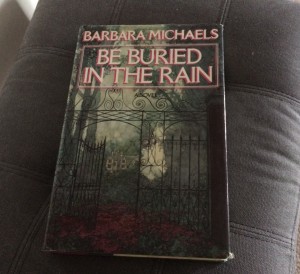
I’ll say this for our protagonist: faced with ailing and nutty relatives, she does not start watching Highlander obsessively. I’ve heard that can happen.
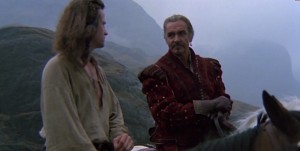
Instead Julie takes matters into her own hands, reading to her grandmother by day—if you break it down into real time, this is probably a book about a woman reading Bleak House aloud—and looking into the mystery in her precious free time. This is a mystery story, but it is also a book about family and…well, how family can screw you up.
The Verdict: Only this year have I come to realize how much these books, which I first read as a young teenager, have influenced both the way I write and what my concept of “a novel for grownups” should resemble in general shape and tone. That said, I think in this case the similarities to my own experiences are working against it, making it less interesting than the Michaels books set in Georgetown or farther abroad.
(…And while I was writing this, I remembered that somewhere in my hometown, there may still be video of me doing a book talk for this in the eighth grade. Talk about horrors from the past…)
Might go well with: Country ham biscuits, Dickens, a nice nightgown.
Next time: The hiatus will come to an end and we’ll catch up with the Quest family. I will also be doing something fun here next weekend—by which I mean the weekend after the approaching one.
Like most people, I have a natural tendency to pick up speech patterns from things I watch on TV, and one of the phrases I regularly try to expunge from my vocabulary came from watching several hours of Archer in one go.
It’s hard to expunge “What the shit?!” from one’s speech, however, when what-the-shit-worthy things keep happening—and the latest of these was me sitting down to watch The Highlander Movie That Doesn’t Technically Exist.
Highlander II may be the most what-the-shit thing I’ve ever watched, and I include several Ken Russell films, Scream and Scream Again, and Transylvania 6-5000 on that list.
In fact, one could almost believe in time travel after watching Highlander II: it often feels like a weird melange of movies that came before and after it, including Dune (melange…heh), Dark City, Robocop, Soylent Green, Death Wish, The Fifth Element, the Tim Burton Batman movies, and just a touch of Stargate. The title cards so beloved by the people who make Highlander stuff inform us that the ozone layer went kaput in 1999, glossing over the implication that Connor managed to ruin the earth—okay, okay, or didn’t prevent its ruin— in only 14 years. Now, in 2024, the world is covered by a shield and everything looks very urban-apocalypse.
You know I’m going to say it.
HOW COULD THIS POSSIBLY BE WORSE IF THE KURGAN WON?? THE WHOLE DAMN MOVIE MATCHES HIS OUTFIT!
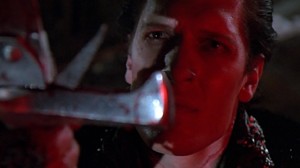
This is also the movie in which it is revealed that immortals are actually aliens, because that always makes everything better and doesn’t at all stomp viciously on the historical-supernatural intersection that makes the whole Highlander idea interesting in the first place. It does provide a convenient explanation for bringing back Ramirez, though, who I don’t mind nearly as much in this film—he’s a lousy Mr. Miyagi, but “running around and getting things done” has always been Connery’s cinematic bread and butter, so he’s much better used here.
And our villain this time is the alien world’s ruler, Gen. Katana (really, people?), played by Michael Ironside as…I guess as the kind of despot we were supposed to fear in the first movie. (Other immortals probably have to watch Extreme Prejudice as a PSA.) What the Kurgan—and Kane, and Slan—did for unwieldy cars, this guy does for subway trains, and therein lies one of the movie’s strengths: the action sequences are pretty good. I wish I hadn’t had to watch the rest of this to see Connor MacLeod on hover-skates, but I did, and it’s kind of fun.
This is probably the liveliest the Highlander has ever been onscreen, and a pity that it’s in service of this font of subsequent audience amnesia. I started watching Highlander II thinking perhaps the classic Roger Ebert review had been too harsh, since the late, great critic never seemed to have much affinity for any of the genres it could be said to occupy; I eventually concluded that if he had been versed in the Highlander franchise, Ebert might have been even harsher.
Oh, and in this film, rather than dying circa 1993 in a car crash, Brenda dies of solar radiation in 1999. What the shit?
Next time: Get out your Warren Zevon music.
Last time:
42. The answer to life, the (princes of the) universe, and everything: Endgame.
Highlander: Endgame (which, yes, isn’t the last film) brings together the movie and TV Highlanderverses and reunites the two MacLeods.
The answer to the question most viewers probably asked themselves is answered when, in the first minutes, the villains kill Rachel from the original movie. Endgame is very much a series-mythos story rather than any sort of return to Connor’s world—though that means we get a little Methos and Dawson in this tale of a self-hating immortal who’s formed his own ruthless death cult.
One of the cult’s members is Duncan’s ex-wife, who is understandably bitter about that time he stabbed her on their wedding night because he knew she was an immortal (she didn’t) and because good old Cousin Connor put the idea in his head that she should die while in her full youth and vitality (in fairness, he presumably meant later: Connor isn’t stupid, though I have a harder time making that argument about Duncan once he does this Groom of Lammermoor bit here). Eventually it becomes clear that they will have to combine forces to defeat the evil Jacob Kell—and that means one MacLeod must take the other’s head.
[If anyone cares after all this time, spoiler a…head?]
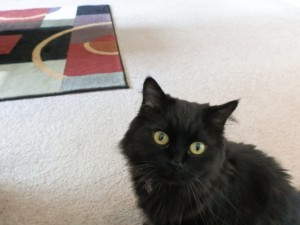
That would be Duncan, of course, after some convincing and a long speech from Connor about how tired he is of being immortal and losing everyone he loves. I don’t think this result could have been planned since 1986, but if the Highlander movies were intended as a long-form portrayal of living with depression, my hat is off to everyone involved, because it works completely and would explain Connor’s apparent ennui in the first film.
I find myself struggling to explain what I dislike about Endgame, since “It’s so dark!” inevitably leaves me wondering why the first movie seems less dark. Possibly it shouldn’t: it’s a thematically similar idea, except the Kurgan wasn’t allergic to fun like the ex-priest villain here, but there were also a few genuinely comic moments. I don’t miss Ramirez—hoo boy, I do NOT miss Ramirez—but I miss the effect he had on the tone of the first Highlander.
Still, Endgame has its moments for viewers like me, and for the part of my cinematic credo which reads, “There is no such thing as a bad swordfight.”
Next time: I finally got around to starting 2013’s Dracula TV series (would someone pleeeease let Daniel Knauf finish a show?), so I’m going to re-view the Coppola movie.
Next time on TCBOM? The audio plans are still up in the air, so though there may yet be an audio discussion or two, next week I’ll be doing something else on Mondays. It’s been fun!
Last time: Duncan MacLeod made new friends…at about a tenth of the rate at which he makes enemies. But one of them is Dawson, so how bad can it be?
41. A Methos to the madness.
This will probably be a short one, since I talked about the series formula last week and a few of the overarching conflicts (the research monkey in me notes with regret that every time there is an erudite secret society calling themselves The Watchers, large numbers of them turn out to be evil. Where are my people?).
While still keeping the formula alive, the show in its later seasons suffers from the same problems afflicting a lot of supernatural-inflected television series, with new rules and new evil creatures popping up everywhere as the stakes are constantly raised. (Spoiler alert! There’s even a plot arc in which, thanks to the machinations of a demon, Richie Ryan is finally sent to the Great Scrappy-Doo Kennel In The Sky.)
And then there’s Methos (portrayed by the awesome Peter Wingfield), a name you probably know if you’ve ever looked for Highlander fan fiction—or possibly any fanfic that could cross over with the world of immortals. An ancient immortal who was undercover for years as a Watcher, Methos is kind of a uniting figure, and not just across the two groups that make up the world of Highlander: the Series. As we eventually learn, he used to ride with a band of barbarians called The Four Horsemen before settling down to a quiet life.
Yep, that’s right: Methos is what you get when the Kurgan decides he wants to be Connor MacLeod when he grows up. He is pretty much the Highlander universe incarnate (only likable! I kid, mostly), which presumably explains his popularity. And it doesn’t hurt that his one impersonator, in the inevitable episode where such a thing happens, is played by Ron Perlman. That’s a mark of quality if I ever saw one.
You can probably tell from this that I’m not altogether fond of the series as a whole, even if Duncan is an engaging protagonist and many of the supporting characters are great. For all I whined about not being able to gauge how things worked for immortals during the original film, learning more about them in the series is a bit like finding out how a magician does his tricks: some of the gloss is gone.
Not that this will stop me from linking to my favorite episode, which is highly entertaining in the vein I described in my Lois & Clark post last week:
Next time: I reread a childhood classic…well, my kind of childhood classic… for the first time in decades. I am terrified.
Next time on TCBOM!: The last Highlander movie I’ll be writing about, i.e., the one I tend to call Highlander: the MacLeod Popularity Referendum.
Last time: I wanted a buddy movie with Slan and the Kurgan. Also, we bade Connor a temporary farewell, to which he probably responded by looking at us bleakly.
40. A very brief tour of the early seasons. Also, recipe for a series.
The last time I watched Highlander: the Series with any regularity, I was also working my way through a friend’s collection of James Lee Burke novels. It took longer than I like to admit to see that the show and Burke’s Dave Robicheaux mysteries have the same formula:
This sounds tedious in list form, but it’s my kind of formula. I love shows in which the episodes are variations on a theme: Le Monstre de la Semaine, c’est moi, as Louis XIV might’ve said had he watched Kolchak. The Problematic Immortal of the Week serves just as well, and includes recurring bad guys like Xavier St. Cloud (Roland Gift, as though having that Fine Young Cannibals song carved into the hard drive of our brains wasn’t evil enough), amoral thief Amanda—a character who would eventually get her own spinoff—and friends of Duncan’s like Hugh Fitzcairn (Roger Daltrey).
The second season introduces the Watchers, who keep tabs on immortals, and Duncan’s in particular, Joe Dawson (played by Jim Byrnes, who I’ve loved since Wiseguy, for heaven’s sake). How great is Dawson? he gets to do the opening-credits narration, that’s how great. He owns a bookstore, he is full of esoteric knowledge, and he can kick no small amount of ass. If the whole Highlander universe had to come down to one character surviving, I would, albeit regretfully, choose him—sorry, Rachel from the first movie, you’re number 3.
The nice thing about the series is that they go to the trouble of hammering out answers to some of the questions the first movie raises, like what happens when an immortal is killed by mortals or by non-sword means, what happens when ordinary people find out about the whole Gathering/ruler-of-the-world thing (spoiler: nothing good), and how much trickery plays a part in the duels. It’s a great fleshing out of hundreds of little what-if scenarios.
Also, more or less in order:
As unnatural as it seems to break an overview in the 3/4-point of a season, the Big Bad of season 3, Kalas, brings us to a sort of turning point in the series—more on that later.
Next time: No idea. It’s been a crazy week.
Next time on TCBOM!: It’s a really old guy who wants to be left alone! Now we can start the party? Or, Dial M for Ethos.
Today will be the first part of my discussion about the Highlander TV series. First, a confession that will probably inform everything I write about this show:
I HATE RICHIE RYAN.
Sorry.
I do, though.
In theory, the series solves one of the problems with the Highlander franchise by removing Connor. Instead it focuses on his younger cousin Duncan, who has charm and killer abs and a visible will to live. Duncan MacLeod is played by Adrian Paul, and though I didn’t remember it when Highlander: The Series first appeared, I’d seen him before both as a dancer on The Colbys and in the early-’90s Dark Shadows revival as Barnabas Collins’s ill-fated brother. (I’ll bet you always wondered who watched that show.)
Connor does show up in the first episode to pass the torch, as it were–and since I’d never seen it before, I decided to give this one its own TCBOM! entry.
When the show begins, Duncan is living in “retirement” from the whole beheading thing with his mortal girlfriend, industrial sculptor Tessa. They are—surprise!—running an antique store, a fact that makes me begin to wonder if the next town over from mine is merely quaint or secretly infested with immortals.
Richie, a “streetwise” thief who exudes all the menace and worldly experience of the bad kid in an after-school special, is caught trying to rob the store. It’s what must, to someone else, be the beginning of a beautiful friendship (especially since Richie is a not-yet-“killed” immortal); Duncan bails him out of jail and eventually takes him as a sort of sidekick.
The episode itself is a crash course in the Highlanderverse, with the music and a discussion about the perils of mortal/immortal relationships, with flashbacks and a treasure cave of sorts (Duncan’s is less blatant and has a lovely fireplace) and the “villains should drive like madmen” rule firmly in place.
And just like the first movie, a lot of the energy in the episode comes from the bad guy. This is the last time I’ll say “and so-and-so as the Kurgan, kind of,” but Richard Moll (Bull the bailiff from Night Court, for those of us who watched too much TV in the ’80s) is not only a wild-eyed, leather-clad, articulate barbarian, he’s GREAT at it.
In fact, there are only two things I dislike about this episode, other than Richie and my old nemesis “Who Wants To Live Forever?”:
I’m resisting the temptation to say this opening sequence “turns the Freudian symbolism up to eleven,” but darn it, you know what I mean. They’re missing a comma, too.
Next time: An even bigger fairy tale.
Next time on TCBOM!: Going to spend two more weeks on the series, then move on to Endgame. (Those of you familiar with Highlander movie-naming conventions will correctly deduce that’s not the last movie, either.)
Today we’ll take a brief look at the third…I mean, clearly the second movie in the series, Highlander: The Final Dimension. (Doubtless you’re thinking, “‘Final’? This isn’t even the penultimate movie!” You’d be correct. The whole franchise seems to have a real problem with the concept of finality, as the recent talk of a reboot only confirms.)
For this one, I’ll borrow a bit of the format from my Friday posts.
Known to casual observers as: Highlander: the one in which Mario van Peebles plays the Kurgan, sort of, and there’s some kinda kung fu, I guess?
The Premise: Connor must defeat some long-trapped immortals after an archaeological dig accidentally sets them free; it turns out the Highlander’s not The One after all. (Is there any way to fit that into continuity unless Connor had a psychotic break at the end of the first movie? Somewhere, the Kurgan is laughing, admittedly through a neck stump.)
Complicating this good-vs.-evil plot are a number of human factors, including Connor’s adopted son (Brenda has apparently died in a car crash), a cop who seems to be the official NYPD holder of the grudge against “Russell Nash,” and a beautiful archaeologist who is, shall we say, interested in old bones.
Did I mention the bad guy has magical illusion powers he got from killing one of Connor’s mentors? That too.
As I poke around the internet, I get the distinct impression that most people regard all the Highlander sequels as crap. There’s a certain amount of truth to that—I can’t say this is a particularly great movie even by Highlander standards—but Final Dimension does present some interesting features. The villain, Kane, is a blatant Kurgan ripoff on a scale I couldn’t exceed even if I were doing it myself, but at least he and his men are seen actually destroying a village at one point, and Kane’s illusion power makes the “put someone Connor loves in a car and terrorize them by driving like a maniac” sequence superior to the one in the original film. It’s also nice to see the franchise acknowledging its debt to martial-arts movies with Connor’s training in the initial flashback sequence. It also shines new light on…
The Connor problem: When I watched this again after starting to write these posts, Netflix threw up the Beowulf movie with Christopher Lambert as a recommendation, and I watched it. I’d always assumed part of Connor’s apparent ennui was due to some flaw in Christopher Lambert’s performance; while he’s not quite a ball of fire in Beowulf, it became clear that the anhedonia is endemic to the Highlander.
(I’d also like to put in a small plug for the 1999 Beowulf. It’s definitely a—whimsical?—take on the legend, but it’s a quite bearable little action flick with steampunk and demon ladies and Oliver Cotton, who was a barbarian king in Robin of Sherwood, as another one. It grows on you.)
The Verdict: I hate to say too many bad things about Final Dimension, as the film does try to address both some things I complained about in the original Highlander and the paradox of its own existence. I will say it’s probably for diehard fans only.
And my god, they use “O Fortuna” in the trailer!
Next time: I say nice things about Christian Slater.
Next time on TCBOM!: Still working on that audio, so it’ll probably be the TV series.
Last time: The whole damn movie, that’s what.
So what did I learn by writing 17,000+ words about Highlander over a timespan similar to the one needed to produce an entire new human being? Let’s take a look.
0. A few hard skills.
I learned how to make screenshots and audio files just to liven things up here on Mondays. As a completely different movie put it, “Education is never a waste.”
1. Things I thought were my fault perhaps aren’t.
I’ve been known to have a little more affection for villains than heroes, but digging in and taking the movie a piece at a time has only strengthened my impression that Connor is…not that great. Reactive, self-pitying and frequently dull, with worse people skills after centuries of practice than even I, a crazed grammar nerd who writes about Highlander as a hobby, would have, the Highlander can be really difficult to like. I’d hoped to appreciate Connor more by the end of this project, but I ended up with a more detailed version of the same opinion. His heart’s in the right place in a “doesn’t want to destroy humanity” sort of way, and he is occasionally amusing, but that’s it. Connor MacLeod is possibly the most low-energy franchise character in movie history—a kind of achievement in itself, I guess.
2. Things I didn’t come up with a good in-world answer for, but really wanted to:
3. Why don’t immortals all run around in thick metal collars? Especially the one who could pull off the look. Speaking of which…
4. The Kurgan isn’t quite as fearsome as advertised, taken incident by incident.
*Sigh*…
He still might be okay as a proofreading client, though, since he is careless only about the chief focus of his entire existence. If you want me, I’ll be watching that Amélie clip up there a few more times.
5. My conviction that if this series of posts is ever widely read, I’ll go down in history as “that heartless jerk who hates Ramirez—my god, woman, don’t you like fun?” hasn’t budged a bit.
I am patient zero for Connery Guilt.
6: A list of things I kind of compared the movie to over time: Folk songs, The Incredibles (“monologuing!”), Death Wish and Police Squad! (at the same time), Black Adder, the farmers’ market in the next town, Jeepers Creepers and Iron John (also at the same time), Dracula, a song by Heart, Tess of the D’Urbervilles, Zorro movies, various religious writings, The Secret of NIMH, Bugs Bunny cartoons, Santa Barbara, and, more often than I’d like to admit, Spaceballs.
7. …And none of that matters.
In a way, I slowly failed over the last nine months, because what I wanted most was to understand the hold Highlander has over me and its fans in general. Certainly there’s a lot to dissect there, and a lot of rampant silliness, but I’m no closer to putting my finger on the mystique of the movie than I was at the beginning. In fact, it’s worse now: I’ve watched Highlander once a week for most of a year, and there were very few weeks I wanted to give it a miss, and very few in which I didn’t sit down and watch the whole thing, even if I was only writing about half of Connor and Brenda’s awful date. It’s the most staggering case of the whole being greater than the sum of its parts I’ve ever encountered—maybe in any medium.
My main conclusion? Writing this has been kind of fun. I also think my headphones + Highlander habit became a full-fledged hobby the day I was watching Connor ride into battle to the tune of Shirley Bassey’s “History Repeating.”
Also, from my compatriot:
Audio Player
Next time: A musical interlude.
Next time on TCBOM!: I plan to continue There Can Be Only Monday! for a few more weeks as I take a look at some of the sequels (not that one) and the TV series that started it all for me.